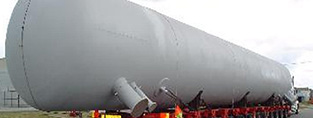
- (03) 5909 8218
- enquiry@fusionweld.com.au
Pressure Vessel Testing and Inspection: Do’s and Don’ts
February 21, 2017

There's very little leeway when an engineer is conducting a pressure vessel testing and inspection assignment. Ideally, there's just no room for gray areas and ambiguous results. The test and inspection procedure should yield a simple binary result, an informed "YES" or "NO" that imparts unbiased operability data. Intelligently generated checklists and incisive inspections, as performed by engineering professionals, govern this procedure. To the uninitiated, though, we can break these tasks down into a list of Do's and Don'ts, beginning with product deference.
Do Respect Pressure Vessels
This is a powerful construct, an engineered container that's designed to contain a potentially dangerous fluid. Even if that fluid isn't normally hazardous, it's now pressurized to such a degree that it has transformed from a gas into a liquid. Always treat the vessel with respect and adopt any duly legislated safe operating procedures when working on a container complex.
Do Adopt a Distributed Test Method
Use procedural test routines. This includes a visual integrity test and a series of approved electronic tests via the latest ultra-sensitive instruments. Material flaws and seam irregularities are detected in this manner, as are joint defects. A nominal test technology configurations incorporate a radiography rig and an ultrasonic inspection.
Don't Sidestep Active Mechanical Tests
The ASME regulations and several other publications make this point clear: the vessel must undergo a physical (hydrostatic) pressure test. Electronically regulated inspection routines have their place, of course, but the structure must be actively exposed to a pressurized fluid so that any and all unpredictable defects can be picked up before the vessel is certified for service.
Don't Neglect Extraneous Vessel Assets
The vessel's design geometry should reflect the original and updated design drawings. Any weld joints and internal support mechanisms should also follow this structured guideline. Of course, in following these big ticket items, there should still be a focal point reserved for other system attachments. Safety valves, in particular, must be tested to assure proper operability, across the board.
A working pressure vessel is dimensionally sparse, yet there's an astonishing amount of engineering shrewdness ingrained within this enclosed package. Pressure variables, for instance, are rarely fixed. They change dynamically, alter forcefully to create chemical changes and fluid state changes. In adhering to the ASME regulations, and whatever national legislature dominates a particular region, we develop a series of predictable steps. It's these steps that regulate the Do's and Don'ts that govern pressure vessel testing and inspection procedures.
Contact Details
Fusion - Weld Engineering Pty Ltd
ABN 98 068 987619
1865 Frankston Flinders Road,
Hastings, VIC 3915
Ph: (03) 5909 8218
Optimized by NetwizardSEO.com.au
Recent Posts
- Pressure Vessel Fabrication: Engineering Efficiency for 2026 Petrochemical Projects
- Heat Exchanger Maintenance in Melbourne: Minimising Risk in Power Generation Facilities
- Compressed Hydrogen Storage Vessels: Material Selection, Design & Australian Standards
- Welding QA/QC in Oil & Gas Pressure Vessel Fabrication – Ensuring Code Compliance
- AS1210 vs ASME VIII Pressure Vessel Code: Key Differences for Australian Projects
- Mitigating Hydrogen-Induced Cracking in Pressure Vessels: Engineering and Material Strategies
- Storage Tank Solutions Australia: Field-Erected, Prefabricated & Self-Bunded Explained
- Reducing Environmental Risks: Self-Bunded Tanks in Australian Oil & Gas Operations
- Precision in Production: How Pressure Vessels Are Manufactured for Industrial Safety
- Shell & Tube Heat Exchangers: Improve Thermal Control & Energy Recovery in Petrochemical & Pharmaceutical Plants
- In-Service Inspection for Compressed Air Receivers for Power Plant Shutdown Prevention
- Power Plant Pipe Spooling Fabrication – Get Rapid, Code-Compliant Spools Ready for Installation
Posts 2026
- Pressure Vessel Fabrication: Engineering Efficiency for 2026 Petrochemical Projects
- Heat Exchanger Maintenance in Melbourne: Minimising Risk in Power Generation Facilities
- View all articles…
Posts 2025
- Compressed Hydrogen Storage Vessels: Material Selection, Design & Australian Standards
- Welding QA/QC in Oil & Gas Pressure Vessel Fabrication – Ensuring Code Compliance
- View all articles…
Posts 2024
- Large Process Vessels: Optimising the Design for Maximum Efficiency [2025]
- Pressure Equipment Management System Installation: Detect Equipment Faults Early
- View all articles…
Posts 2023
- Pressure Piping System Inspection: A Gift of Safety for the Holidays
- Deaerator Inspections by Fusion-Weld Engineering and How They Reduce System Downtime
- View all articles…
Posts 2022
- How Fusion Weld Keeps Up With AS-NZS ISO 9001:2008 Standard
- Boiler Equipment Safety Inspection During the Summer Season
- View all articles…
Posts 2021
- Avoid These Factors and Practices that Contribute to Sealing Damage in Pressure Vessels
- Do's And Don'ts Of Industrial Boiler Inspection And Maintenance From Fusion-Weld
- View all articles…
Posts 2020
- What are the Risks and Hazards Involved in Pressure Vessel Equipment?
- How to Know if Your Pressure Equipment Needs Repair or Replacement?
- View all articles…
Posts 2019
- Factors that Contribute to Pressure Vessel Failure
- Pressure Vessel Regulations in Australia: What are the Mandatory Requirements?
- View all articles…
Posts 2018
- Pros and Cons of Spherical vs. Cylindrical Pressure Vessels
- What are the Different Hazard Levels in Pressure Vessels?
- View all articles…
Posts 2017
- Transportable Pressure Vessels: The Importance of Inspection and Safety Checks
- Fracture Mechanics and Stress Analysis of Cracks in Pressure Vessels
- View all articles…
Posts 2016
Posts 2015
- What Are Deaerators & Feedwater Vessels?
- Precautions and Safety for Compressed Air Receiver Vessels
- View all articles…
Posts 2014
- Demonstrating In-process Inspection Procedures
- Static Grounding Practices and Standards
- View all articles…